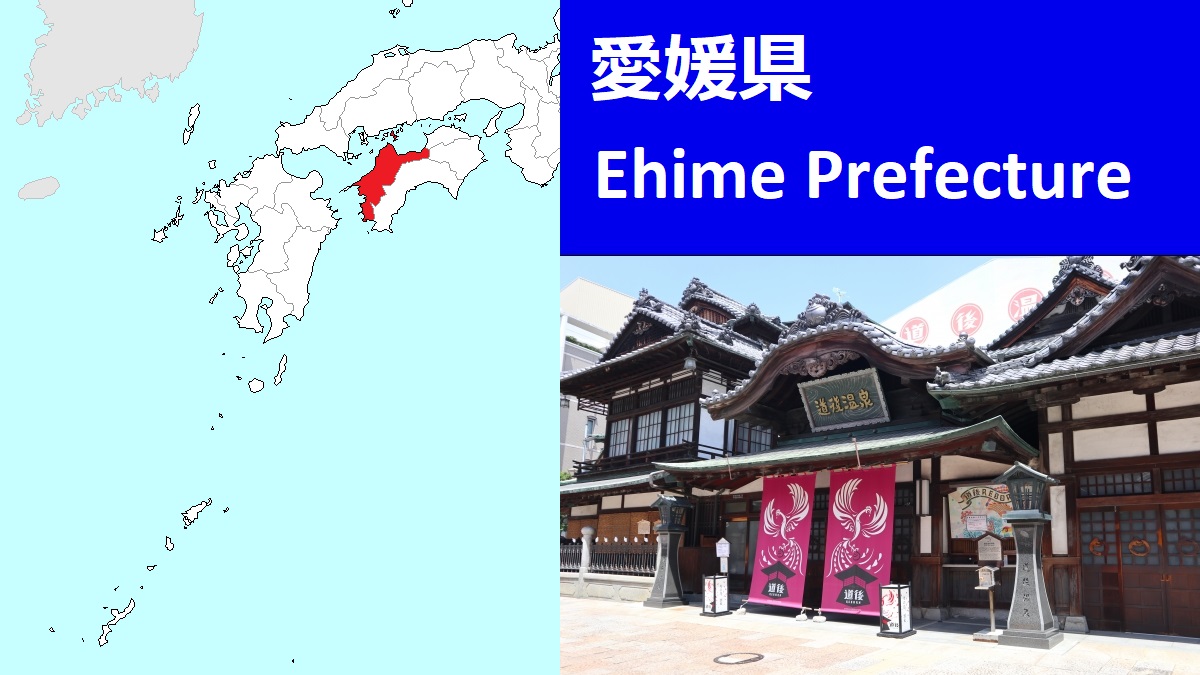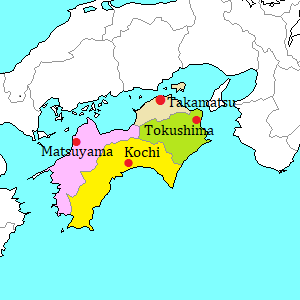Ehime Prefecture [愛媛県]
Ehime Prefecture is the prefecture covering the west and northwest areas of Shikoku Island.
The northern coast faces Seto Inland Sea (Seto Naikai).
Very long and narrow Sadamisaki Peninsula stretches to the west, and is like a breakwater of Seto Inland Sea.
The south side of the peninsula is called Uwa Sea.
The old name of Ehime Prefecture is Iyo (伊予).
In Iyo area, eight feudal clans were set up in the 17th century, and some of them had a castle.
Each clan made a castle town and became the current city in Ehime Prefecture.
So a few cities preserve the historic atmosphere.
The major clan was Matsuyama.
Matsuyama city (松山) is the current prefectural capital and is located near the center of the prefecture.
It is the largest city in Shikoku Island and has a population of about 500 thousand people.
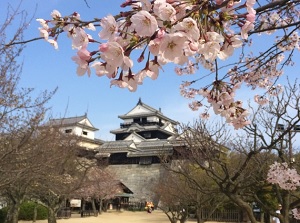
Matsuyama Castle
In 1906, Natsume Soseki (1867-1916), one of famous Japanese novelists, published a novel "Botchan".
The story is set in Matsuyama, and describes the human events around a young teacher from Tokyo humorously.
("Botchan" is a polite word meaning "a son of the other person".)
Before Soseki wrote this novel, he had worked in Matsuyama as a school teacher for a year.
His experience in this city created this excellent novel.
Since the publication, this novel became popular in Japan.
Because this work still appears in textbooks for junior high school, most Japanese people should have read it once at least.
So Japanese people associate "Matsuyama" with "Botchan" and "Soseki".
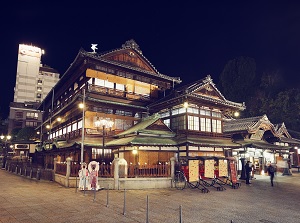
Main bathhouse of Dogo Onsen in Matsuyama
Photo by Dogo Onsen
Masaoka Shiki (1867-1902) was a classmate of Soseki in Tokyo University.
He was born in Matsuyama, and was an excellent Haiku poet.
He died young from tuberculosis unfortunately, but his work had greatly influenced Japanese literary world.
It is said that he created about 23,600 poems of Haiku in his short life.
There are some spots related to Soseki and Shiki in Matsuyama.
There are flatlands around Matsuyama city and along the northern coast, but other area is mountainous.
To the east of Matsuyama city, there is Mount Ishizuchi (1,982 m) which is the highest mountain in Shokoku Island.
Along the northern coast, industrial area spreads.
In the area along the western coast, fishing industry is main.
Especially, Ehime Prefecture leads Japan in the production of cultured sea bream.
"Mikan" is a kind of Japanese mandarin orange, and Ehime Prefecture is one of the top three producers in Japan.
Tourist Attractions in Ehime Prefecture
Shikoku 88 temples pilgrimage
Transportation
Railway
- To Matsuyama from Takamatsu : About 2 hours and 45 minutes by JR limited express.
- To Matsuayama from Okayama : About 2 hours and 30 minutes by JR limited express.
- To Uwajima from Matsuyama : About 1 hour and 20 minutes.
Express bus
- To Matsuyama from Tokyo : about 11.5 hours. (Night bus)
- To Matsuyama from Osaka : about 6 hours.
Airport
Matsuayama Airport is located about 5 km west of JR Matsuyama station.
It has the flights from Haneda (Tokyo), Narita, Itami (Osaka), Chubu (Nagoya), Fukuoka and a few cities.
Main events in Ehime Prefecture
Saijo Festival (Around October 15)
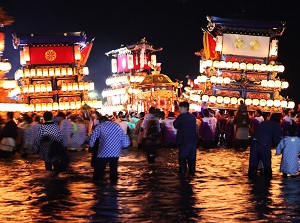
Photo by Ehime Prefecture
Saijo Festival is the annual events of four Shinto shrines in Saijo city located at the northeast part of Ehime Prefecture.
The shrines are Isono Shrine, Iwaoka Shrine, Iizumi Shrine and Kamo Shrine.
The festivel of each shrine is held on different day around October 15, and each festival is held for two days.
Each shrine has many floats called "Danjiri", and the people pull them and march through the streets.
Isono Shrine has the largest scale of the festival, and more than 80 Danjiri floats are pulled.
This festival has been held since the middle of the 18th century.
Saijo citizens love this festival, but they think that this festival is not an event for attracting many visitors but one of important Shinto rituals.
Niihama Taiko Festival (October 16 - 18)
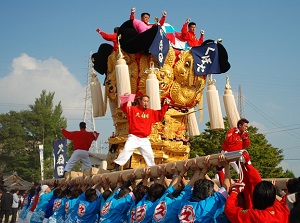
Niihama Taiko Festival is the annual event held in Niihama city located about 10 km east of Saijo city.
The festival was started around late 19th century, and is the most dynamic but the roughest festival in Shikoku Island.
"Taiko" means "Japanese drum", and about 150 men carry a frame on which a big Taiko with colorful decoration is set up.
A few men beat the Taiko on the frame, and they march through the streets.
And the frame is sometimes raised above the men to show their powers and gorgeousness of the decoration.
Every year, some fightings between the frames occur in excitement.
Some say that it is a sight to see, but it has resulted in many injuries and arrested men every year.
Bull Sumo (Bullfighting) in Uwajima
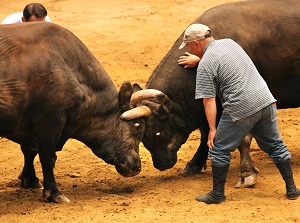
Photo by Ehime Prefecture
Uwajima is one of the towns where bullfighting takes place, and is the only one place in Shikoku Island.
Two bulls controlled by men butt each other.
When a bull flees, the game is over.
So it is translated as "Bull Sumo" in English.
(Therefore, this is diffrent from bullfighting in Spain.)
Bullfighting in Uwajima has been held from ancient times.
The best days were in the early 20th century, and seeing bullfighting was the popular amusement in Uwajima.
Now, five tournaments a year are held for preservation of the traditional culture and tourism.
Local foods and products in Ehime Prefecture
Tai-meshi
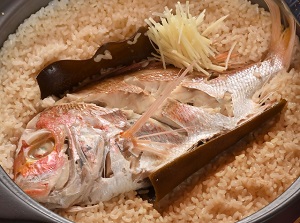
Tai-meshi in Matsuyama area
Tai-meshi is a dish that sliced sea bream (a fish with white flesh) are topped on rice.
"Tai" means "sea bream" and "meshi" means "rice".
It is a popular local cuisine in Ehime Prefecture.
But there are some differences in cooking method between the northern part (e.g. Matsuyama, Imabari) and the southren part (e.g. Uwajima).
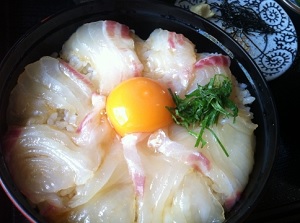
Tai-meshi in Uwajima area
In the northern part, rice and broth soup are put in an earthenware pot, and sliced or whole sea bream is topped on the rice, then it is boiled after getting a lid on the pot.
In the southern part, sliced raw sea bream is used.
Some pieces of them are topped on boiled rice, the mixed sauce of beaten egg, soy sauce and dashi broth is poured, and chopped green onion, nori (dried laver seaweed) and sesami are topped.
Jakoten
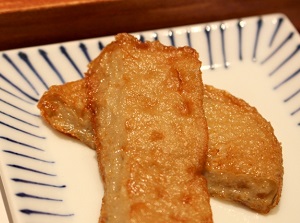
Jakoten is a deep-fried fish paste produced mainly in the southern part of Ehime Prefecture.
Similar foods are produced all over Japan, but Ehime's one is made from a deep-sea fish named "Hotaru-jako".
The head and guts are removed from the fish, and the flesh, bones and skin are minced.
And thin and rectanglar cakes of the mince are deep-fried.
These are made in factory, and we can get them at the shop in Ehime Prefecture.
Ehime Mikan
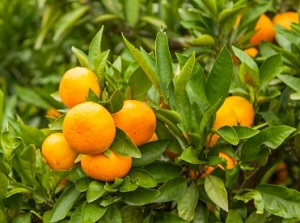
Mikan is a popular citrus fruit in Japan.
Ehime Prefecture boasts a production volume second only to Wakayama Prefecture.
The climate is warm and there are many slopes to receive plenty of sunlight.
In Ehime Prefecture, the production volume of Mikan is larger than rice.
In addition, "POM Juice" is a mikan juice product made by a company in Ehime Prefecture.
The juice is sold across the country.
In Ehime Prefecture, POM Juice is distributed to all pupils in the public elementary and junior high schools at lunchtime once a week in summer.
Some say, "POM Juice is the blood of the people of Ehime".
Imabari Towel
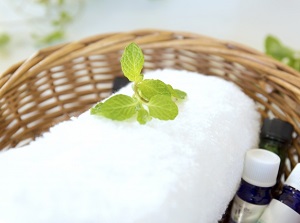
Imabari is a city located about 35 km northeast of Matsuyama, and has been the largest production center of towel in Japan.
The production was started in 1894, but the industry is suffering from cheap imports from China recently.
Now, high-quality towels are produced in Imabari.
The water absorption capability is high, and even new towel sinks in water within five seconds.

